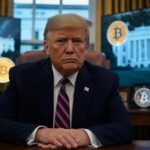Now Reading: Federal Reserve Keeps Key Interest Rate Unchanged
-
01
Federal Reserve Keeps Key Interest Rate Unchanged
Federal Reserve Keeps Key Interest Rate Unchanged
:max_bytes(150000):strip_icc()/GettyImages-2213944260-ed1ffd9ea0d84d9bb0a539aa6a2cbfae.jpg?w=1920&resize=1920,1267&ssl=1)
:max_bytes(150000):strip_icc():format(jpeg)/GettyImages-2213944260-ed1ffd9ea0d84d9bb0a539aa6a2cbfae.jpg)
Key Takeaways
- The Federal Reserve kept the central bank’s key interest rate in a range of 4.25% to 4.5%, the same as it’s been since December.
- The Fed has been waiting to see how President Donald Trump’s tariffs affect the economy before making any moves.
- If tariffs stoke inflation, the Fed could keep its key interest rate higher for longer, while a surge in unemployment could pressure the Fed to cut rates.
- The fed funds rate influences interest rates on credit cards, auto loans, and other debt.
As widely expected, the Federal Reserve left the central bank’s key interest rate unchanged Wednesday, staying firmly in “wait and see” mode.
The Fed’s policy committee voted unanimously to keep the fed funds rate at a range of 4.25% to 4.5%, the same as it’s been since December. After cutting interest rates three times late last year, the Fed has held its rate flat to see how President Donald Trump’s policies, especially the tariffs that mostly went into effect in April, will change the economy.
In an official statement released with the policy decision, Fed officials gave little indication of when rate cuts might resume. In recent speeches, policymakers have said tariffs risk pushing up the cost of living and hurting employment, which would be setbacks to both sides of the central bank’s “dual mandate” to keep inflation and unemployment low.
Federal Reserve Chair Jerome Powell highlighted that risk in a post-announcement press conference in Washington.
“If the large increases in tariffs that have been announced are sustained, they’re likely to generate a rise in inflation, a slowdown in economic growth and an increase in unemployment,” he said.
The Fed’s monetary policy playbook calls for lowering rates—which would push down borrowing costs on all kinds of loans and stimulate spending—if the economy slows down severely. However, the remedy for higher inflation would be keeping interest rates higher for longer, potentially putting the Fed between a rock and a hard place if both of those problems worsen.
“The Committee is attentive to the risks to both sides of its dual mandate and judges that the risks of higher unemployment and higher inflation have risen,” the FOMC said in an official statement.
How Did The Fed Get Here?
In recent years, the Fed has kept its interest rate at a higher-than-normal level to counteract the post-pandemic inflation surge. The high fed funds rate has pushed up borrowing costs on credit cards, car loans, and other debt to balance demand and push inflation toward the Fed’s 2% annual goal.
The Fed is facing political pressure to take action from President Donald Trump, who has frequently demanded that central bankers lower interest rates. The Fed is not under direct control of the White House and is supposed to be independent to stay above the political fray.
What’s Next For the Fed?
Economic data could force the Fed’s hand before too much longer. Many economists expect the tariffs to take their toll on the job market in the next few months. Business leaders have said in surveys that they are cutting back on hiring and investment because of the added costs of tariffs and the uncertainty about whether or not they’ll be lifted.
A major open question stoking uncertainty is whether the Trump administration will strike trade deals with trading partners to remove or lower the tariffs.
So far, the job market has held steady, with employment running near record lows, while inflation has stayed stubborn just above the 2% goal, giving the Fed some breathing room to stay patient.
Financial markets are pricing in the likelihood of the Fed lowering interest rates at its meeting in July, according to the CME Group’s FedWatch tool. The tool forecasts rate movements based on fed funds futures trading data.
If and when the Fed does decide to step in to lower rates, it may be too late to prevent a serious slowdown, Matthew Pallai, chief investment officer at Nomura Capital Management, wrote in a commentary.
“They may need to run a higher risk of falling into recession than most would like before they have enough evidence to make a decision,” Pallai wrote. “Managing interest rates may be too blunt a tool to navigate between two obstacles—higher unemployment versus higher inflation—that require changes to interest rates in opposite directions.”
Update: This article has been updated after publication to include comments from Fed chair Jerome Powell.













:max_bytes(150000):strip_icc()/4-JacobWackerhausen-b9bfb70f1b55473d9b2998f575afa102.jpg?w=1024&resize=1024,1024&ssl=1)
:max_bytes(150000):strip_icc()/GettyImages-2212037618-ea3ad814ab1544f086f41200566db79a.jpg?w=1024&resize=1024,1024&ssl=1)
:max_bytes(150000):strip_icc()/GettyImages-2184968478-4dc218844aa043d8a4eb4cad523179aa.jpg?w=1024&resize=1024,1024&ssl=1)











:max_bytes(150000):strip_icc()/4-JacobWackerhausen-b9bfb70f1b55473d9b2998f575afa102.jpg?w=150&resize=150,150&ssl=1)

